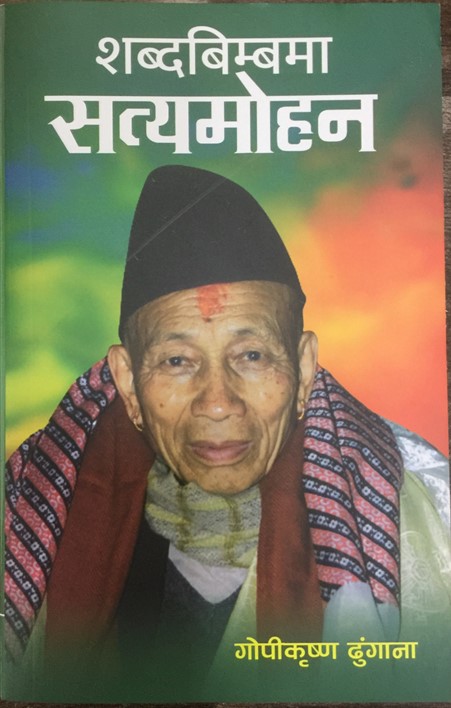Narayan Prasad Ghimire/RSS
Kathmandu, Sept 26:
The book under review is ‘Shabdabimbama Satyamohan’ (Satyamohan in Word Image). As the title suggests, the book edited by journalist Gopikrishna Dhungana is a compilation of articles, interviews, and features written on noted expert on culture, Satyamohan Joshi- some during his life and some posthumously.
The articles, opinions and editorials on culture expert Joshi range from Rastrakavi Madhav Prasad Ghimire to critic Ram Dayal Rakesh. The editor has finely compiled the writings on Satyamohan depicting his philosophy, knowledge, advocacy of truth and unparalleled contribution to Nepali culture, and literature. It is a text that speaks a lot on versatility of centenary figure, Satyamohan.
Born in a traditional Newari family in Patan near Krishna Mandir in 1977BS, Satyamohan saw multiple systems of Nepal- Rana regime, monarchy, democracy and republic in his centenary plus life. A man down-to-earth had ardent love for Nepali cultures, literature and language, and devoted his life for their promotion and protection. He was bold and rebellious as well. He was firm on protecting tradition, but embraced science by deciding to donate his lifeless body after death to a hospital for study. The writers in this collection have taken such decision of Satyamohan as his rebellion and boldness.
Satyamohan was a courageous man- he visited New Zealand and Australia when Nepal was yet to open to other world. He conducted a rigorous study on culture and language at historic Sinja Valley of Jumla district in remote Karnali region. He coordinated the research team to conduct study on Sinja Valley despite sheer inconvenience and dearth of resources- even the basic facilities were out of access. His research and documentation thereafter brought Karnali to the attention of rulers. It was Satyamohan to make early effort to mainstream Karnali region.
Importantly, Satyamohan was always for satya (truth) in life. He used to find truth in simple living. The writings in this book suggest that Staymohan was like a romantic poet who loved 3C’s: common people, common place and common thing. ‘Jureli’, (bulbul), a common bird becomes philosophy of his life- truth and simplicity. Jureli teaches him to be simple and find satisfaction in ordinary living. This said, he was not for banal affairs at all. To the editor of this book, Dhungana, centenary figure Satyamohan had said, “I’m influenced by jureli bird, its life and philosophy of simplicity. I want to live especially in a way that jureli bird lives.” Here, it shows the celebration of nature by Satyamohan. He used to focus on ‘satyam’, ‘shivam’, ‘sundaram’ (truth, love and beauty).
Satyamohan, although a denizen of city, had fervent love to rusticity, common people and diversity. He was curious to find meaning in ordinary lifestyle and diverse cultures. The curiosity and zeal were significant drives in Satyamohan’s life which made him famous. He earned accolade for his study and research on Karnali life and culture. He got ‘Madan Puraskar’ for writing ‘Hamro Lok Sanskriti’ (2013). He was only person to receive Madan Puraskar thrice- in 2013BS for his book ‘Hamro Lok Sanskriti’ (Our Folk Culture), in 2017BS for his book ‘Hamro Mudra’ (Our Currency), and in 2028BS for his book ‘Karnali Lok Sanskriti’ (Karnali Folk Culture).
According to Rastrakavi Ghimire, Satyamohan’s contribution to the country could be studied from three dimensions- cultural, literary and administrative. As the Rastrakavi Ghimire observed, it was Satyamohan Joshi to lay administrative foundation of Nepal Academy.
He was a man of staid demeanor. The documentation of folklores by Satyamohan has evidently enriched Nepali culture and literature. His love of country irrespective of geography, culture, ethnicity, is inspiring.
Writing about Styamohan Joshi, Tirtha Bahadur Shrestha describes Joshi’s love for national attire- daura, suruwal and topi. Shrestha recounts what Joshi had shared with him about his visit to New Zealand and the hospitality there: ‘When I landed in New Zealand, my happiness was boundless seeing the hospitality there. We were taking lunch sharing a table. Finding me strange, others in the table looked at me with keen interest. But, I was attired in simple daura, suruwal and topi.’ Finding a man in topi, a newspaper in New Zealand had published his image in the front page. Seeing this, Joshi was gleeful, which he shared later with his friends after return to Nepal.
Philosophy of simplicity, tolerance and coexistence are worth inspirational for all of us. At a time when we are now on an unhealthy race to be superior and competing each other, Satyamohan’s philosophy of simplicity, respect and tolerance bears much significance.
Critic Ram Dayal Rakesh dubs him as precursor of culture, while Khem Koirala Bandhu writes: ‘When Satyamohan Joshi was director at Department of Archaeology in 2015 BS, he was only 38-years-old. He has published ten books on culture in his authorship. Satyamohan is the first person to give detailed information on artist Araniko to Nepalis. Joshi was a researcher.’
The book, compiling the eulogy writings on Satyamohan, is a resourceful documentation on Nepal’s colossus figure on culture. It is published by Bhundipuran Publications. The book costs Rs 590.




